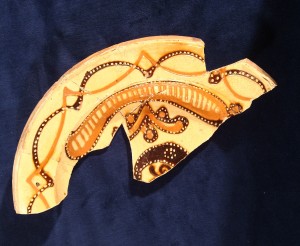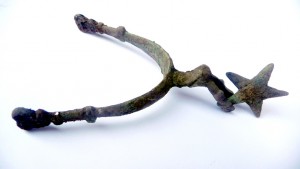Two thousand years of urban life
Archaeological excavations in 2001 and 2002, in advance of an extension to the Debenhams store, uncovered a wealth of evidence for 2,000 years of Chester’s history. The site was behind the shops on Bridge Street Row and Eastgate Row, in the heart of the medieval city and the Roman legionary fortress. A wide range of artefacts were found, including rare types of Roman roof tile, Spanish mackerel bones, glass goblets and an elephant bone!

A late 17th century slipware dish – one of the items on display. It has been skilfully decorated using dark brown, orange and white slips. It could have been made by one of the well-known slipware potters of Staffordshire.
A small selection of the artefacts is now on display in the Newstead Gallery at the Grosvenor Museum.
The work on the excavation and study of the artefacts, combined with documentary references, has enabled us to build up a detailed picture of Chester’s urban history and the trades, lifestyle and status of the people who lived in the area. If you would like to know more, we have
published the results of the work and the report is available from the shop in the
Grosvenor Museum, Grosvenor Street, price £30, or it can be ordered from the
museum, tel 01244 972112 or e-mail:
grosvenor.museum@cheshirewestandchester.gov.uk
The excavations were carried out by Gifford and Partners in association with Cheshire West and Chester Council’s Historic Environment Service. The work was generously funded by Debenhams plc
Excavations in Grosvenor Park, Chester
Since 2007 archaeologists from Cheshire West and Chester’s Cultural Service, in partnership with Chester University, have run an annual training dig in Grosvenor Park, Chester, for the second-year archaeology students. The dig aims to find out more about the area surrounding the Roman amphitheatre, to explore the past of the park and to give students the important excavation experience they need to gain their degrees.
Some of the thousands of artefacts recovered during the excavations are now on display in the Newstead Gallery at the Grosvenor Museum.
The excavations have made some significant discoveries about the Roman, medieval and later remains that still survive underground. Over the course of the last ten years the excavations have uncovered:
* a Roman road running westwards across the park to the amphitheatre
* a very large ditch running north-south across the park
* dumps of demolition debris from a sixteenth or early seventeenth-century building and
* the thick stone walls of a medieval building.
Though most of the stone had been robbed out from the medieval building, it is believed to be part of the north-eastern corner of the precinct of the church of St John the Baptist; perhaps the hospital and chapel of the Fraternity of St Anne which was acquired by Sir Hugh Cholmondeley in the late sixteenth century and converted into a large house, later destroyed in the Civil War. The ditch may be the early boundary of St John’s Precinct. The students have made a blog that relates their experiences and discoveries over the years and includes photographs of the archaeological remains.

